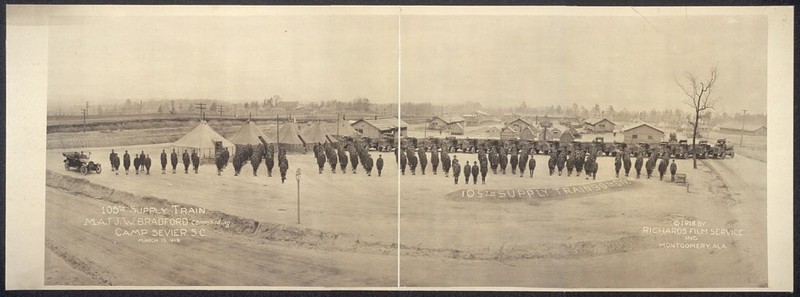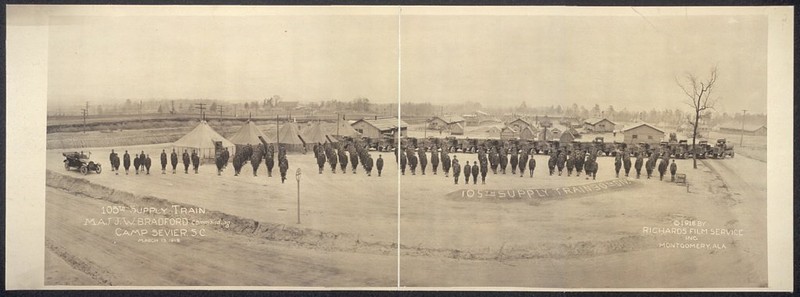Camp Sevier Historical Marker
Introduction
Text-to-speech Audio
Images
105th Supply Train, Maj. J.W. Bradford commanding, Camp Sevier, S.C., March 13, 1918 Library of congress - Richards Film Service

Camp Sevier, Greenville, S.C. Peden, J. R., photographer,1917 October 18.

West from "Y" 82, at Paris, Camp Sevier, S.C. Peden, J. R., photographer, 1918 September 13.

North-East from "Y" 82, Camp Sevier, S.C. Peden, J. R., photographer,1918 September 13.

North-West, no. 1, from Stockade Tower, Camp Sevier, S.C. Peden, J. R., photographer,1918 September 11

South-west from Stockade Tower, no. 1, Camp Sevier, S.C Peden, J. R., photographer,1918 September 11.

Backstory and Context
Text-to-speech Audio
America entered World War I in April of 1917, but the government did not have a sizable army and many of the National Guard troops were not yet trained for the kind of warfare they might see in the trenches of France. Congress and the military decided within months of entering the war to ramp up mobilization. Then Governor Richard Irvine Manning III moved quickly to make sure that South Carolina was involved in the war effort in a way that would also provide economic benefits for his state.
Camp Sevier was one of 16 other US. National Guard mobilization and training camps. It was established just three months after the United States joined the war. The leaders of the camp trained National Guard units and the camp had a capacity of 46,000 officers and enlisted men on a site of 1,900 acres. The first unit would become what would be known as the 30th US. Infantry Division. They held the nickname “Old Hickory” in honor of President Andrew Jackson.
This 30th Division would train from August 1917 until May 1918. They would be followed by the 81st Division from May until July 1918. The last soldiers to train at the camp were the 20th Division who trained here from August 1918 until February 1919. Both the 30th and 81st would fight in important battles in WWI. The 30th Division was initially attached to the British 2nd Army and fought in the Ypres-Lys and Somme offensives. These men were part of two American divisions who helped to break the Hindenburg Line during the Battle of St. Quentin Canal. They would be demobilized in May 1919 at Fort Jackson.
The 81st Division, nicknamed “Wildcat” would also play a large part in the war. Once they arrived on the western front in August 1918 they defended the St. Die sector. The would later be attached to the American 1st Army and fight in the major offense of Meuse-Argonne. This was a part of the Hundred Days offensive that ended the war. The 81st continued to stay in Europe after the German armistice until May 1919. The camp served a demobilization center until April of 1919 and was then turned over to the Public Health Service.
Sources
Scott, Brian. Camp Sevier. THE HISTORICAL MARKER DATABASE. April 23, 2018. Accessed September 16, 2018. https://www.hmdb.org/marker.asp?MarkerID=10475.
Weaver, Jeffrey C. Order of Battle - American Forces World War I. New River Notes. . Accessed September 16, 2018. https://www.newrivernotes.com/topical_history_ww1_oob_american_forces.htm.
Thayer, Bill. Harry F. Hodges. Cullum's Register. July 04, 2016. Accessed September 18, 2018. http://penelope.uchicago.edu/Thayer/E/Gazetteer/Places/America/United_States/Army/USMA/Cullums_Register/2882*.html.
Brief Histories of Divisions, U.S. Army: 1917-1918. Vol. 92. U.S.A. General Staff, June 1921. pages, 37-38
Roberts, Robert B. The US Army in World War I - Orders of Battle. Tiger Lily Publications LLC, 2004. page 38-39
Camp Servier - Panoramic pthotograpths. Library of Congress. . Accessed September 21, 2018. https://www.loc.gov/collections/panoramic-photographs/?fa=location%3Acamp+sevier&st=grid.
